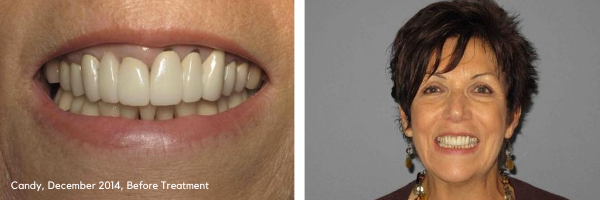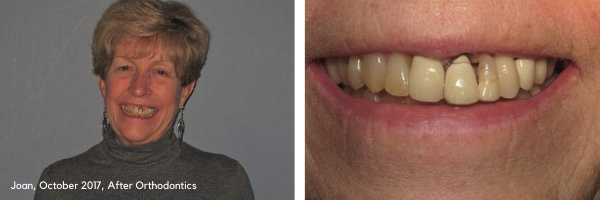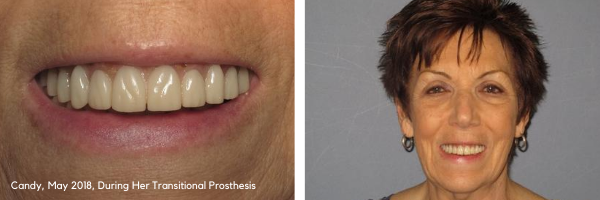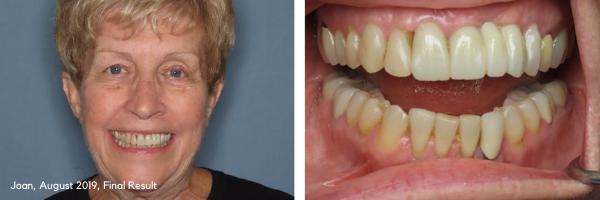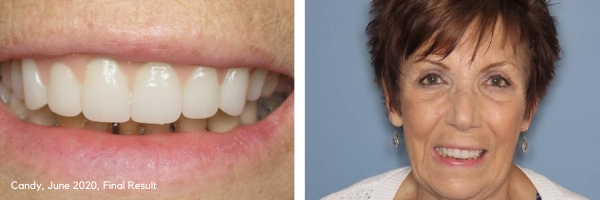By Dr. Elizabeth Eggert
Choosing the right tooth replacement method should start with an exam and a dialogue with your dentists, Dr. Elizabeth and Dr. Jeff. They are happy to take the time you need to understand the variables of your available options, including dental health, overall health, how long it will last, how long it will take, and financial impact. We want to help you choose the treatment that makes the most sense for your situation and bring you the greatest satisfaction.
Replacing Teeth with Dental Implants
Dental implants consist of three components. A titanium post is fixed into the bone where a tooth was. The jaw bone grows back around the implant, holding it firmly. When the implant has integrated with the bone, an abutment is fitted on the implant, and then a crown is attached to the abutment.
Implants help keep adjacent teeth and your entire mouth more resilient to deterioration. When a tooth is lost, a few things begin to take place that may not be easily evident to the eye, but can have significant negative consequences for both health and appearance. Tooth roots not only help hold teeth in place, they are also essential in maintaining health in the adjacent gums and supporting bones.
Thus, tooth loss can cause bone loss in the jawbone. This is a problem because it can interfere with the integrity of the roots and stability of nearby teeth. This bone loss is also responsible for the “sunken” appearance of the lower cheeks which we see in people who have lost back teeth. Because this bone loss is gradual, it causes people who wear dentures to find that their dentures are increasingly hard to fit and keep in place, over time.
With an implant, bite function is fully restored to as good as new. Neighboring teeth are prevented from shifting. The jaw bone is much more stable and stays where it belongs. Additionally, implants look and feel like your own teeth, and you care for them just the same as your regular teeth. Plus, the longevity is unmatched, with them lasting many years.
The comfort, function and appearance of a dental implant explain why they have become so popular.
Replacing Teeth with All-on-4® Dental Implants
All-on-4® Dental Implants are a relatively new dental reconstruction. In a way, they are a hybrid of implants and a bridge. With this technique, four (or more) implants are placed in the jawbone and an entire arch of reconstructed upper or lower teeth are affixed to the four (or more) imlants. This is a more comfortable, stable and long-lasting option than traditional dentures. Plus, they look and feel just like “real” teeth.
Replacing Teeth with Fixed Bridges
A fixed bridge fills in the gap caused by one or more missing teeth by using surrounding teeth as anchors. A bridge can be a fairly quick way to replace teeth, but since it relies on the neighboring teeth, the integrity of these anchor teeth is reduced. Bridges can also be more difficult to keep clean than other tooth replacement options because food will trap under the “fake” teeth.
Replacing Teeth with Removable Partial Dentures
Partial dentures are able to replace one or more teeth in an arch They consist of replacement teeth attached to a plastic base and often a metal framework, which is supported by the gums and teeth. They are removed for cleaning. They are more comfortable and secure than full dentures, and usually cost less than implants or bridges.
Replacing Teeth with Full Dentures
Full dentures are an entire set of artificial lower and upper teeth, held in place by suction. They are removed for cleaning. When they’re brand new, they may feel awkward and speaking and eating might require practice. Over time, they may stop fitting properly as bone mass degrades.
To learn more about your tooth replacement options, call us at Eggert Family Dentistry, 651-482-8412.




